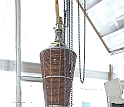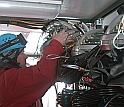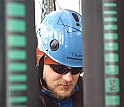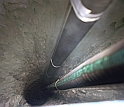Media Advisory 06-010
Polar Neutrino Observatory Takes a Big Step Forward
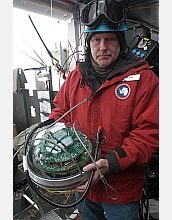
Robert Paulos holds one of the optical sensing modules.
March 21, 2006
For still images contact Peter West. For B-roll of IceCube drilling operations at NSF's Amundsen-Scott South Pole Station and animations of the nature of neutrinos, contact Dena Headlee at (703)292-7739.
This material is available primarily for archival purposes. Telephone numbers or other contact information may be out of date; please see current contact information at media contacts.
During the recent austral summer, an international team of scientists and engineers took a major step forward in building a subglacial instrument known as IceCube, which is designed to detect high-energy subatomic particles called neutrinos. The team harnessed a sophisticated hot-water drill to install hundreds of basketball-sized optical modules in the South Pole ice sheet that will eventually form a detector encompassing a cubic kilometer of ice.
Through a joint project of its Office of Polar Programs and its mathematical and physical sciences directorate, NSF is contributing more than $240 million to the international partnership that is building the $272-million detector. Germany, Sweden and Belgium are also contributing to the project. The University of Wisconsin-Madison is leading the drilling and science operations.
Neutrinos are created in galactic collisions, distant black holes, quasars and a host of the most violent events in the cosmos. When fully operational, IceCube will use 4,200 light-sensing modules to sample neutrinos from the sky in the Northern Hemisphere, using the Earth as a filter to exclude other types of neutrinos, such as those from the Sun.
Once the holes are drilled, 1.5-mile (2.5-kilometer) cables holding the spherical digital optical modules--which are composed of electronics for sensing light and circuit boards for gathering and processing data--are frozen in place. The modules detect evidence of neutrinos when they collide with other particles. The devices then relay data to the surface where the information is processed and stored for analysis.
The IceCube project is an international collaboration of scientists from more than 30 scientific organizations and more than a dozen U.S. universities.
-NSF-
-
A firn drill is used to melt snow at the surface.
Credit and Larger Version -
A worker takes a sensor from the shelves at the South Pole drilling site.
Credit and Larger Version -
Terry Bensen watches the drilling equipment come up from the hole.
Credit and Larger Version -
Detectors are frozen in place nearly 1.5 miles deep in the ice.
Credit and Larger Version
Media Contacts
Terry Devitt, University of Wisconsin, (608) 262-8282, email: trdevitt@wisc.edu
B-Roll Contacts
Peter West, NSF, (703) 292-7761, email: pwest@nsf.gov
Dena Headlee, NSF, (703) 292-7739, email: dheadlee@nsf.gov
Related Websites
The University of Wisconsin Icecube website: http://icecube.wisc.edu/
The U.S. National Science Foundation propels the nation forward by advancing fundamental research in all fields of science and engineering. NSF supports research and people by providing facilities, instruments and funding to support their ingenuity and sustain the U.S. as a global leader in research and innovation. With a fiscal year 2023 budget of $9.5 billion, NSF funds reach all 50 states through grants to nearly 2,000 colleges, universities and institutions. Each year, NSF receives more than 40,000 competitive proposals and makes about 11,000 new awards. Those awards include support for cooperative research with industry, Arctic and Antarctic research and operations, and U.S. participation in international scientific efforts.
Connect with us online
NSF website: nsf.gov
NSF News: nsf.gov/news
For News Media: nsf.gov/news/newsroom
Statistics: nsf.gov/statistics/
Awards database: nsf.gov/awardsearch/
Follow us on social
Twitter: twitter.com/NSF
Facebook: facebook.com/US.NSF
Instagram: instagram.com/nsfgov

